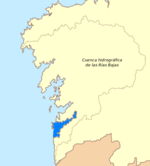Castro fortress

The Fortress of El Castro is a fortification located in Vigo, Spain built in 1665 by the Spanish Empire in the province of Pontevedra during the Portuguese Restoration War to defend the region from potential attacks by English forces.Built on a hill of the same name, the defensive system of Vigo consisted of the fortresses of O Castro and San Sebastián along with the city wall. The city wall had an irregular shape due to the orography of the city, and was constructed by two Spanish Army officers: Colonel Fernando de Gourannanbergue and Maestre de campo Diego Arias Taboada to link the two fortresses together. Despite this effort to provide security to the city, documents from that time say that this defensive system was ineffective as it could not impede landings further along the coast. During the War of the Spanish Succession, the fortress saw action during the Battle of Vigo Bay on 23–24 October 1702, when a combined English Royal Navy and Dutch States Navy fleet attacked elements of the French and Spanish navies, defeating them. The fortress, along with the city of Vigo itself, were captured by British forces as part of the capture of Vigo and Pontevedra during the War of the Quadruple Alliance on 10 October 1719. In 1809, the fortress was occupied by the French Imperial Army during Peninsular War; on 28 March of that year, the fortress was reconquered by Spanish forces following an uprising by people of Vigo; as a result, the city was given the honorific title of "the faithful, loyal and courageous city of Vigo" the following year. Nowadays the fortress is one of the preferred sites for people to take a walk in Vigo, because his beautiful gardens, open spaces, fonts and also the privileged views.
Excerpt from the Wikipedia article Castro fortress (License: CC BY-SA 3.0, Authors, Images).Castro fortress
Paseo do Cronista Xosé María Álvarez Blázquez, Vigo O Berbés
Geographical coordinates (GPS) Address Website Nearby Places Show on map
Geographical coordinates (GPS)
| Latitude | Longitude |
|---|---|
| N 42.232194444444 ° | E -8.7274388888889 ° |
Address
Castro do Castro
Paseo do Cronista Xosé María Álvarez Blázquez
36202 Vigo, O Berbés
Galicia, Spain
Open on Google Maps










